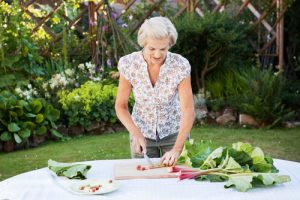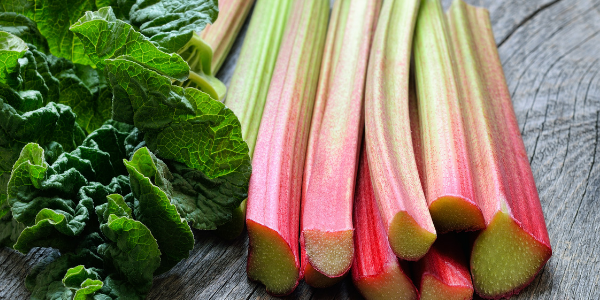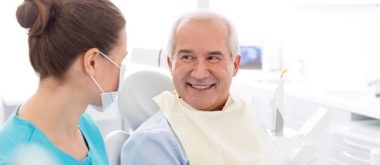Rhubarb is a vegetable known for reddish stalks and sour taste; its stalks are commonly cooked with sugar and used to make jams, jellies, salads and desserts. Stalks of the rhubarb plant range from green to pale pink and vibrant red, and they require cold winters in order to flourish in spring and summer seasons.
How Is Rhubarb Used?
Because of its extremely sour taste, rhubarb has typically been cooked with sugar and added to other foods. When sugar became inexpensive and widely available in the 18th century, rhubarb rose to popularity in cooking and baking. It is rarely eaten raw.
In ancient China, it was used medicinally, when dried roots were used to treat everything from skin conditions to fever. The health benefits of rhubarb are still relatively unknown in Western medicine, although in the herbal and naturopathic communities, supplements and dried forms of the plant are popping up in protocols designed for optimal health and wellness.
Nutritional Value of Rhubarb
Many of the health benefits of rhubarb can be attributed to its high nutritive content. Per serving, rhubarb contains:
- 31 g carbs
- 2 g fiber
- 0.4 g protein
- 26 percent of the daily recommended requirement of vitamin K
- 15 percent of the daily recommended requirement of calcium
- 6 percent of the daily recommended requirement of vitamin C
- 3 percent of the daily recommended requirement of potassium
- 1 percent of the daily recommended requirement of folate
As we age, it is essential that we keep tabs on our intake of vitamins and minerals, as they are the building blocks of cellular repair and renewal. Discovering the health benefits of rhubarb for those of us interested in maintaining our health as we age will be helpful as we look for ways to boost nutrition and gain more energy naturally.
 What Are the Health Benefits of Rhubarb?
What Are the Health Benefits of Rhubarb?
Although studies on this common plant are surprisingly limited, more information is coming to light about how rhubarb can have a significant effect on our health as we age. Consider these benefits as you seek to feel younger, longer:
Fiber helps regulate your digestive and elimination systems; these need to keep moving efficiently in order to keep your body clean and free from toxic buildup. Rhubarb is an excellent source of dietary fiber, and as most of us do not eat enough of it, consider adding some rhubarb to your regular intake to stay “regular.”
Rhubarb is an excellent source of vitamin K, which is needed for bone density and development. Vitamin K is also needed to facilitate healthy clotting processes and for heart health. All of this extra protection is needed as we age.
Can you believe it? Just one serving of rhubarb has twice the antioxidant content of a serving of kale. Antioxidants help protect your cells from free radical damage and repair damaged cells, protecting them from further degeneration. Who says rhubarb can’t be added to salads, soups, and smoothies? Get a little creative with regard to how you incorporate it, and you’ll likely develop more of an appreciation for this vibrant garden plant.
Rhubarb contains phenolic acid and anthocyanin, both of which are known to fight levels of inflammation in the body. These powerful compounds also work to reduce the risk of heart disease, diabetes and protect your vascular system, which is very important for your overall health.
The excellent vitamin and mineral content in rhubarb makes it a perfect component to your beauty routine—both inside and out. People, who regularly consume rhubarb, note improvements in both skin tone and hair texture—who doesn’t want these youthful benefits as they get older? Gnaw on a stalk with your morning smoothie, or spread some rhubarb jam on your toast at tea time for a natural boost of hair and skin beauty.

- Helping to protect systems of the body that suffer due to declining estrogen levels
- Protecting and preserving brain health, thus reducing symptoms of brain fog
- Helping to balance hormones that may be fluctuating as a result of menopausal conditions
Whether you consume it raw or cooked, in jams and jellies or as part of a delicious cup of tea, you’ll feel better as hormone levels are balanced and your hot flashes diminish with every serving.
Bottom Line
With the health benefits of rhubarb becoming more mainstream, we need to explore this power plant in-depth and see just what it can do to rejuvenate our health as we age. Experiment with all of the different ways you can incorporate it into your diet and look forward to better health and vitality with every serving.

 What Are the Health Benefits of Rhubarb?
What Are the Health Benefits of Rhubarb?



